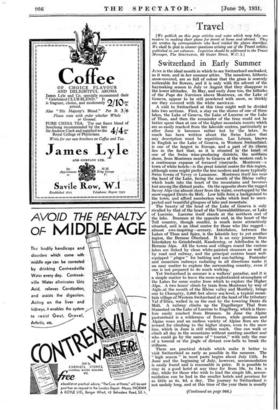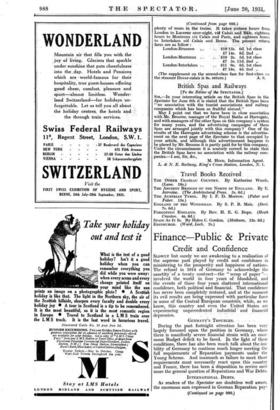Travel
[We publish on this page articles and notes which may help our readers in making their plans for travel at home and abroad. They are written by correspondents who have visited the, places described. We shall be glad to answer questions arising out of the Travel articles :shed in our columns. Inquiries should be addressed to the Travel anager, The SPECTATOR, 99 Gower Street, 'W .C.1.]
Switzerland in Early Summer
JUNE is the ideal month in which to see Switzerland uncloaked, as it were, and in her summer attire. The meadows, hitherto snow-covered, are so full of colour that the grass is scarcely noticeable for flowers, and it is only with the advent of the haymaking season in July or August that they disappear in the lower altitudes. In May, and early June too, the hillsides of the Pays des Narcisses above Montreux, on the Lake of Geneva, appear to be still powdered with snow, so thickly are they covered with the white narcissus.
A visit to Switzerland at this time might well be divided into two sections. First, a stay on the shores of one of three lakes, the Lake of Geneva, the Lake of Lucerne or the Lake of Thun, and then the remainder of the time could not be better spent than at one of the higher mountain resorts which are so easily reached from the lakeside centres,' particularly as after June it becomes rather hot by the lakes. So much has been written about the Swiss Lakes that any description must be repetition. Lac Leman, latqwn in English as the Lake of Geneva, in Western Switzerland, is one of the largest in Europe, and a part of its charm lies in the fact that, as it is situated in the heart of one of the Swiss wine-producing districts, the northern shore, from Montreux nearly to Geneva at the western end, is a continuous expanse of terraced vineyards. Montreux—a town of white hotels—is the great tourist centre for this region, although some might prefer the less modern and more typically Swiss towns of Vevey or Lausanne. Montreux itself lies near the head of the Lake, facing the mouth of the Rhone valley which leads into the heart of the mountains and becomes lost among the distant peaks. On the opposite shore the rugged Savoy Alps rise almost sheer from the water, overtopped by the snow-capped Dents du Midi. Low hills form a background to the town, and afford numberless walks which lead to unex- pected and beautiful glimpses of lake and mountain:
The beauty of the head of the Lake of Geneva is only rivalled by that of the head of the Vierwaldstattersee, or Lake of Lucerne. Lucerne itself stands at the northern end of the lake. Brunnen at the opposite end, in the heart- of:the Tell country, though smaller, is much more attractively situated, and is an ideal centre for those who like rugged— almost awe-inspiring—scenery. Interlaken, between the Lakes of Thun and Spiez, is the lakeside key to yet another region, the Bernese Oberland. It is an easy journey from Interlaken to Grindelwald, Kandersteg, or Adelboden in the BerneSe Alps. All the towns and villages round the various lakes are linked by clean white-painted steamers as well as by road and railway, and the principal centres boast well- equipped "plages " for bathing and sun-bathing. Funicular and mountain railways radiating in all directions make it an easy matter to explore the surrounding country, even if one is not prepared to do much walking.
Yet Switzerland in summer is a walkers' paradise, and it is a simple matter to leave the more sophisticated atmosphere of the Lakes for some centre from which to explore the Higher Alps. .A two hours' climb by train from Montrewc by way of Aigle, at the mouth of the Rhone valley and Monthey, brings one to Champery, 3,000 feet above sea-level, a typical moun- tain village.of.Westem Switzerland at the head of the tributary Val d'Illiez, walled in on the east by the towering Dents du Midi. A railway climbs up the Engelberger Thal from Stansstad on the Lake of Lucerne to Engelberg, which is there- fore easily reached from Brunnen. In June the Alpine pastureland is a wilderness of flowers, while gentians and Alpine roses and an endless variety of Alpine flora are the reward for climbing to the higher slopes, even to the snow line, which in June is still within reach. One can walk or climb all day in_ the mountains without meeting another soul who could go by the name of " tourist," with only the roar of a torrent or the jingle of distant cow-bells to break • the stillness.
There are practical details which make it better to visit Switzerland as early as possible in the summer. The " high season " in most parts begins about July 15th. In June and the beginning of July, however, accommodation is easily found and is reasonable in price. It is possible to stay in a good hotel at any time for from 10s. to 14s. a day, while for those who wish to lead the simple life, accom- modation can be had in the smaller hotels and pensions for as little as Os. 8d. a day. The journey to 'Switzerland is not unduly long, and at this time of the year there is usually (Continued on page 988.) (Continued from page 986.) plenty of room in the trains. It takes sixteen hours from London to Lucerne over-night, trill Calais and Bitle, eighteen hours to Montreux vid Calais and Paris, and eighteen hours to Interlaken vid Calais and Berne. The present return fares are as follow : London-Brunnen .. £10 15s. Od. 1st class
£7 14s. 8d. 2nd „
London-Montreux . £10 2s. 5d. 1st class £7 5s. 11d. 2nd „ London-Interlaken .. .. £11 Os. 3d. 1st class £7 18s. 4d. 2nd ,.
(The supplement on the second-class fare for first-class tin the steamer Dover-Calais is 9s. return.) A. S.











































 Previous page
Previous page